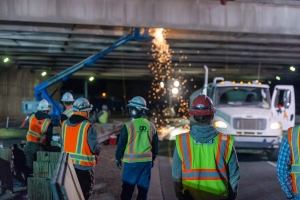Test Owner
Write an IT CV That Gets You Hired
In the fast-paced world of IT recruitment, standing out with a well-crafted CV is essential. But how can you ensure your CV isn’t lost in the pile? Whether you’re applying for a software developer role, a cybersecurity position, or a systems analyst job, tailoring your CV to highlight your technical expertise and critical achievements can significantly increase your chances of landing an interview.
Why Tailoring Your CV is a Game Changer
Customising your CV for each position demonstrates your understanding of the job requirements and shows hiring managers you’re serious about the opportunity. By emphasising the skills, experiences, and keywords that align with the role, you make it easier for recruiters to see why you're the perfect fit. For example, showcasing your experience with platforms like AWS or Azure will make your CV more relevant and compelling if a role focuses on cloud computing.
The Key Sections Every Tech CV Needs
To grab a recruiter’s attention, make sure your CV includes these essential sections:
Personal Statement
This is your chance to make a memorable first impression. A brief, tailored statement that outlines your career goals and critical skills will help recruiters quickly understand who you are and what you bring to the table. Whilst it's tempting, don't let AI do the full job for you. It's important that the reader can tell it's written by a person.
For Example: "Experienced software engineer skilled in Python and Kubernetes, passionate about delivering scalable, high-performance solutions."
Technical Skills
List the programming languages, tools, platforms, and technologies you’re proficient in. Ensure this section is tailored to the job description to highlight the most relevant skills.
Certifications
Highlight certifications demonstrating your commitment to professional development and adding credibility to your skillset, such as AWS Certified Solutions Architect or CompTIA Security+.
Projects and Achievements
Don’t just list your job responsibilities—show how you’ve made an impact. Include specific projects that highlight your technical abilities and provide tangible results.
For Example: "Developed a web-based inventory system that reduced stock discrepancies by 30%."
Optimising Your CV for Applicant Tracking Systems (ATS)
To increase your chances of passing this automated screening, follow these tips:
- Use Standard Headings: Stick to conventional section headings like "Experience," "Education," and "Skills."
- Incorporate Keywords: Use keywords from the job description, such as “Agile,” “cloud solutions,” or “network security,” to improve your chances of being flagged as a match.
- Keep it Simple: Avoid graphics or unusual fonts that confuse the ATS. Stick with a clean, professional layout.
Action Verbs and Technical Keywords to Make Your CV Shine
The right words can make your CV stand out. Use strong action verbs like developed, implemented, optimised, and collaborated to describe your achievements. These verbs demonstrate your proactive approach and ability to contribute effectively to teams and projects.
Include relevant technical keywords like Python, Docker, JavaScript, machine learning, or cloud architecture to show your expertise in specific technologies. This strengthens your CV and helps it pass through ATS filters.
Common IT CV Mistakes You Need to Avoid
Even a well-crafted CV can be undermined by a few simple mistakes. Here’s what to avoid:
Excessive Jargon
While technical language is essential, too much jargon can make your CV more challenging to read. Focus on clarity and use terms that align with the job without overwhelming the reader.
Irrelevant Experiences
Stick to experiences directly related to the IT role you’re applying for. If your previous roles don’t contribute to your candidacy, summarise them briefly or leave them out altogether.
Lack of Quantifiable Achievements
Recruiters love numbers because they show the real impact of your work. Instead of “improved system performance,” say you “increased system uptime by 25% through proactive monitoring.” This makes your achievements more concrete and memorable.
Final Thoughts
Writing a tech CV that stands out requires a thoughtful approach. You'll dramatically increase your chances of landing an interview by tailoring your CV to each job, using impactful language, and ensuring it’s optimised for ATS. Whether you’re just starting in the IT field or looking to take your career to the next level, following these tips will help you create a CV showcasing your skills and position you as a top candidate.
Remember, your CV is more than just a list of past jobs—it’s your marketing tool. Start crafting a CV that gets you noticed and opens doors to new opportunities today!
Imagine a world where potholes are fixed before they even form, traffic jams predict themselves out of existence, and highway maintenance runs smoother than ever—all thanks to artificial intelligence. Sounds futuristic? The future is already here, changing the game for highway engineers.
At Calibre Search, we’ve been watching AI reshape industries, and the world of highway engineering is no exception. Here’s how AI is revolutionising the field—and what it means for you.
Smarter Roads, Safer Journeys
AI isn’t just about robots and algorithms; it’s about making roads smarter and safer. Think of AI as the ultimate problem-solver:
- Predictive Maintenance: Instead of waiting for cracks to appear, AI can predict where road damage will likely happen. Sensors embedded in highways collect stress, temperature, and usage data, helping engineers schedule repairs before issues become hazards.
- Real-Time Traffic Management: AI algorithms analyse traffic patterns in real-time, adjusting signals and rerouting vehicles to ease congestion. Less time in traffic means fewer accidents and happier commuters.
Imagine a world where traffic lights “think” for themselves, optimising flow without human intervention. That’s AI at work.
Data-Driven Decision Making
Gone are the days of relying solely on manual surveys and historical data. AI processes massive amounts of information in seconds, providing insights that would take weeks to uncover.
- Optimised Infrastructure Planning: AI analyses traffic data, weather patterns, and urban growth trends to suggest where new roads or upgrades are needed most.
- Environmental Impact Assessments: AI models can predict how road projects affect local ecosystems, helping engineers design with sustainability in mind.
What used to be guesswork is now an informed, data-backed decision.
The Rise of Autonomous Technologies
AI isn’t just in the background; it’s hitting the roads, literally. Self-driving vehicles rely on AI to navigate, and highway engineers play a critical role in ensuring infrastructure supports this technology.
- Smart Infrastructure: Highways need to “talk” to autonomous cars through connected sensors, bright signage, and road markings designed for machine vision.
- Adaptive Safety Features: AI can adjust speed limits dynamically based on real-time conditions like weather, traffic volume, or accidents ahead.
Highway engineers aren’t just building roads anymore—they’re building intelligent systems.
What Does This Mean for Highway Engineers?
Far from replacing engineers, AI is becoming their most powerful tool. Here’s how it’s changing the role:
- From Reactive to Proactive: Engineers can anticipate issues before they arise, focusing on prevention rather than repair.
- Skill Evolution: There’s a growing demand for engineers understanding data analysis, machine learning basics, and smart infrastructure technologies.
- Collaboration with Tech: Engineers will work closely with data scientists, software developers, and AI specialists to design the highways of the future.
Your expertise in infrastructure, combined with AI’s processing power, creates a future where roads are safer, smarter, and more efficient.
The Road Ahead
AI isn’t a distant concept—it’s already transforming how we design, build, and maintain our roads. Highway engineers who embrace these changes will find themselves at the forefront of innovation.
At Calibre Search, we’re here to connect forward-thinking engineers with opportunities that harness the power of AI. Whether you’re looking to upskill, explore new projects, or find your next role, we’ve got your back.
Ready to drive your career into the future? Let’s talk.
At Calibre Search, we get it—interviews can feel like navigating a roundabout with no exit signs. But don’t worry; we’re here to confidently help you cruise straight into your next highway engineering role. Whether a seasoned pro or fresh out of university, these tips will help you impress even the most challenging interview panels.
1. Research the Company Like You Mean It
You wouldn’t start a project without surveying the site first. The same goes for interviews. Find out what projects the company is proud of. Are they all about smart motorways, sustainable transport, or significant urban developments? Mention these in your interview to show you’re genuinely interested—not just applying to every job you see.
Pro Tip: Instead of saying, "I want to work here because you’re a great company," try: "I was impressed by your work on the M62 smart motorway upgrade, especially how you integrated sustainable drainage solutions. I’d love to bring my experience in traffic flow optimisation to projects like this."
2. Know the Role Inside Out
Don’t just skim the job description. Dive deep. Spot the key skills they’re after—DMRB standards, traffic modelling, Civil 3D, MicroStation. Think of projects where you’ve used these skills. This isn’t the time for vague answers—be specific, detailed, and memorable.
Example: Instead of, "I have experience with traffic modelling," say: "In my previous role, I used PTV Vissim to model traffic patterns for a busy urban junction. I identified bottlenecks and proposed signal timing adjustments that reduced congestion by 18%."
3. Talk Tech, But Keep It Real
Highway engineering is technical, but your interview mustn’t be a data dump. Explain your work like talking to a wise friend—straightforward, confident, and engaging. Highlight the impact of your work. Did you improve traffic flow? Cut costs? Save the day? (Okay, maybe not the last one. But if you did, definitely mention it.)
Pro Tip: Connect the technical with real-world impact: "I designed a new roundabout layout using AutoCAD Civil 3D, which improved traffic flow and reduced accident rates by 12% in the first year."
4. Storytelling Isn’t Just for Kids
Competency-based questions? They’re just storytime for adults—without the bedtime part. Use the STAR method:
- Situation: Set the scene.
- Task: What was your role?
- Action: What did you do?
- Result: What happened because of your actions?
Example: "During a major road resurfacing project (Situation), I was responsible for ensuring compliance with new drainage regulations (Task). I worked with the design team to revise the layout, did site inspections, and provided feedback (Action). As a result, we met compliance ahead of schedule, avoiding fines and cutting costs by 10% (Result)."
5. Don’t Forget Your Soft Skills
Yes, technical skills matter. But so do soft skills. Employers want engineers who can communicate, lead teams, and work with stakeholders because even the best designs need someone who can explain them without putting people to sleep.
Example: "In a stakeholder meeting about a bypass project, I explained complex traffic modelling results to non-technical council members. I used simple visuals and analogies, which helped secure their approval for the design."
6. Ask Questions That Don’t Put Them to Sleep
Interviews aren’t interrogations—they’re conversations. Show you’re engaged with questions like:
- "What’s the most exciting project your team is working on now?"
- "How does the company support continuous professional development?"
- "What challenges is the team currently facing, and how could I help?"
7. Safety and Sustainability: Big Deals, Don’t Skip Them
Health, safety, and sustainability are massive in highway engineering. Be ready to talk about:
- How do you ensure safety in designs and on-site work
- Your approach to sustainability
- Experience with risk assessments or environmental strategies
Example: "In a recent project, I integrated sustainable materials into pavement design, cutting the carbon footprint by 15%. I also conducted risk assessments to ensure site safety during construction."
8. Dress the Part (Even on Zoom)
First impressions matter. Dress professionally, whether it’s in-person or virtual. For online interviews, check your tech and make sure your background doesn’t scream "laundry day." And yes, even if it’s a Zoom call—no one wants to see your Star Wars pyjama bottoms. (Unless it’s a Star Wars-themed highway project, then maybe.)
9. Follow Up Like a Pro
After the interview, send a short, polite follow-up email. Thank them, mention something specific you discussed, and express your excitement.
Example: "Thank you for the insightful conversation about the A14 improvement project. Our discussion about sustainable transport solutions resonated with me, and I’m excited about possibly contributing to your team."
Final Thoughts
At Calibre Search, we’re here to help highway engineers like you find roles where you can thrive. Prepare well, be authentic, and showcase your technical skills and personality.
Ready to land that role? Contact Calibre Search today, and let's get your career in the fast lane—no speed limits on success here.
Your CV isn’t just a document—it’s your first opportunity to make an impression. In the competitive world of highway engineering, a strong CV can be the key to securing interviews and landing your ideal role. Here’s how to craft a CV that grabs attention and sets you apart from the competition.
1. Start with a Powerful Personal Statement
Your statement is the first thing recruiters see—make it count. It should be concise, compelling, and tailored to the role you’re applying for.
Example:
A Chartered Civil Engineer with 8+ years of experience in highway design, maintenance, and infrastructure project management. Skilled in delivering large-scale projects on time and within budget while ensuring regulatory compliance. Passionate about sustainable transport solutions and innovative engineering.
Why it works: It immediately highlights expertise, experience, and key strengths, giving hiring managers a reason to keep reading.
2. Showcase Your Core Skills Upfront
Make it easy for recruiters to identify your strengths by listing key skills in a dedicated section. Structuring them into categories improves readability.
Examples:
- Highway Design & Maintenance: DMRB, BIM, Manual for Streets, pavement rehabilitation
- Drainage & Pavement Engineering: SuDS, pavement material selection, asphalt and concrete mix design
- Traffic & Road Safety: Road safety audits, traffic impact assessments, junction design, speed management
- Software Proficiency: AutoCAD Civil 3D, MX Road, MicroDrainage, OpenRoads, KeySIGN
- Project & Contract Management: NEC, JCT, CDM Regulations compliance, budget management
- Stakeholder Engagement: Liaising with local authorities, contractors, and consultants to ensure project success
3. Focus on Achievements, Not Just Responsibilities
Recruiters want to see how you’ve made a difference. Instead of simply listing job duties, showcase measurable accomplishments.
Weak:
Managed a team of engineers on various projects.
Strong:
Led a team of six engineers on a £50m dual carriageway upgrade, reducing congestion by 30% and cutting costs by 15% through innovative material selection.
Numbers, percentages, and tangible outcomes make your experience stand out.
4. Tailor Your CV for Each Application
Highway engineering covers a broad spectrum of roles. Customise your CV for each job to highlight the most relevant skills and experience. Use industry-specific keywords to improve your chances of passing Applicant Tracking Systems (ATS).
Pro Tip: Study the job description and incorporate key phrases like "highway alignment design," "drainage modelling," or "road safety audits" to align with employer expectations.
5. Keep It Professional and Well-Formatted
A well-structured CV is easier to read and leaves a lasting impression. Follow these formatting guidelines:
- Keep it within two pages – Prioritise relevant experience and key achievements.
- Use clear headings and bullet points – Avoid large blocks of text.
- Choose a professional font (Arial, Calibri, Times New Roman) – Keep it consistent.
- Ensure consistent formatting and spacing – A clean, structured layout enhances readability.
6. Highlight Certifications & Professional Development
Relevant qualifications and certifications can make you a stronger candidate. Display them prominently to showcase your commitment to professional growth.
Include:
- Chartered status: CEng (ICE), IEng
- Memberships: CIHT, IHE, SoRSA
- Site safety qualifications: CSCS, SMSTS, IOSH
- CPD courses: Road safety audits, drainage design, sustainable transport innovations
7. Demonstrate Your Technical Proficiency
Employers look for engineers with hands-on experience in key software and methodologies. List technical skills and provide context on how you've used them.
Examples:
- Pavement design: UKPMS, HDM-4, Pavement ME
- Drainage modelling: MicroDrainage, WinDes, Infoworks ICM
- Traffic analysis: VISSIM, SATURN, PARAMICS, LINSIG
- BIM & 3D Modelling: Revit, Navisworks, InfraWorks, OpenRoads
8. Add a Strong Cover Letter
A tailored cover letter can set you apart from other applicants. Address it to the hiring manager and explain why you fit the role perfectly. Use it as an opportunity to highlight a key achievement that relates to the job.
Example:
“Dear [Hiring Manager’s Name],
I am a dedicated Highway Engineer with extensive experience designing and managing large-scale infrastructure projects. In my role at [Company], I led designing and implementing a £30m road expansion project, improving traffic flow by 40% and enhancing safety measures. I am excited to bring my expertise to [Company] and contribute to your continued success.”
9. Proofread & Seek Feedback
A single typo can create a negative impression. Review your CV carefully using spell-check tools like Grammarly, and ask a colleague or mentor to provide feedback.
Common mistakes to avoid:
- Typos and grammatical errors
- Inconsistent formatting
- Vague descriptions instead of specific achievements
- Including outdated or irrelevant information
10. Keep Your CV Up to Date
Even if you’re not job hunting, update your CV every six months. Documenting new skills, projects, and achievements ensures you’re always prepared for future opportunities.
Final Thoughts
A well-crafted CV showcases your expertise, achievements, and potential, making you stand out in the competitive field of highway engineering. Follow these tips to maximise your chances of securing interviews and advancing your career.
Looking for your next opportunity? Get in touch with the team at Calibre Search—we connect talented engineers with top employers across the UK.
Artificial Intelligence (AI) has revolutionised industries, and Java development is no exception. For Java developers, AI offers tools that simplify workflows, enhance productivity, and improve learning. But let’s clear the air—AI isn’t here to take your job; it’s here to make it easier.
In this blog, we’ll dive into how AI can help Java developers, highlight some of the best tools, and explain why AI will never fully replace the human touch in software development.
How AI Can Help Java Developers
Whether you’re an experienced developer or just starting your career, AI can be a valuable ally in multiple areas:
1. Code Assistance and Automation
AI tools like GitHub Copilot and Tabnine act as coding assistants, suggesting code snippets, auto-completing functions, and identifying potential errors. These tools save time by handling repetitive tasks, allowing developers to focus on solving complex problems.
For instance, GitHub Copilot uses OpenAI’s Codex to generate context-aware suggestions as you type. It’s like having a pair of extra eyes to guide your development.
Why It Matters:
Instead of spending hours debugging or figuring out boilerplate code, AI tools streamline the process so you can focus on creating innovative solutions.
2. Debugging Made Simpler
Debugging is a critical but often time-consuming part of development. AI-powered tools like DeepCode (now part of Snyk) analyse your codebase to detect vulnerabilities, inefficiencies, or bugs. They provide actionable suggestions, saving hours of manual effort.
Example in Action:
Imagine working on a legacy Java application with thousands of lines of code. Instead of manually tracing an error, an AI tool can pinpoint the issue and suggest a fix almost instantly.
3. Upskilling and Learning
AI-powered platforms like CodinGame and Codewars make learning interactive and fun. For Java developers, these platforms offer challenges tailored to your skill level, helping you master new concepts. Additionally, AI-driven platforms like LeetCode analyse your performance and recommend areas to focus on.
Pro Tip: Use platforms like Coursera or Pluralsight, which utilise AI to personalise your learning path and stay updated with the latest Java trends like microservices and Spring Boot.
4. Smarter Testing
Testing is integral to software development, and AI tools are changing the game here, too. Tools like Testim and Applitools use AI to create brilliant test scripts, detect anomalies, and maintain your tests as your code evolves.
The Benefit:
These tools reduce the maintenance overhead of manual testing and ensure your application performs as expected, even after updates.
Tools Every Java Developer Should Know
Here are some of the most valuable AI tools for Java developers:
- GitHub Copilot: An AI pair programmer suggesting real-time code snippets.
- Tabnine: An AI-powered code completion tool.
- Snyk: A tool for finding and fixing security vulnerabilities in your code.
- Testim: For creating automated tests powered by AI.
- DeepCode: A tool for improving code quality by detecting bugs and vulnerabilities.
Why AI Won’t Replace Java Developers
There’s much fearmongering about AI taking over jobs, but here’s the truth: AI is a tool, not a replacement.
1. Creativity is Human
AI can analyse data and suggest solutions but can’t innovate or think outside the box. Java developers bring creativity, intuition, and a deep understanding of user needs—qualities no machine can replicate.
2. Problem-Solving Requires Context
Developers often work within complex ecosystems. AI can assist with technical tasks, but it doesn’t understand the bigger picture or the specific goals of a project. You do.
3. Collaboration and Communication
Software development is rarely a solo activity. It involves teamwork, brainstorming, and stakeholder communication—skills that require a human touch.
4. Ethics and Responsibility
AI doesn’t make ethical decisions or consider the consequences of its actions. Developers are responsible for ensuring their systems are fair, secure, and user-friendly.
As recruiters at Calibre Search, we’ve seen firsthand that companies value these human qualities. Developers who embrace AI as a tool to enhance their skills—not replace them—are in high demand.
Final Thoughts: AI as Your Coding Ally
AI is reshaping how Java developers work, but it’s not here to take over. It’s a powerful tool that helps you code faster, learn smarter, and build better software.
At Calibre Search, we specialise in connecting talented developers like you with companies that value innovation and expertise. Ready to take your career to the next level? Contact us today, and let’s find your perfect role.
IT interviews can be challenging to crack. Between the technical tests, behavioural questions, and the inevitable "tell me about yourself" opener, it’s easy to feel overwhelmed. But here’s the good news: preparation is the key to success. At Calibre Search, we’ve helped countless IT professionals land their dream roles, and now we’re here to help you do the same.
This guide breaks down the most common IT interview questions and gives you clear, practical advice on how to answer them. Let’s get started!
1. Tell Me About Yourself
Why They Ask:
This is your chance to introduce yourself and set the tone for the rest of the interview. Hiring managers want to understand your professional background and what you bring.
How to Answer:
Think of this as your “elevator pitch.” Focus on your career highlights and tailor your response to the job you’re applying for.
Example Answer:
"I’ve worked in IT for five years, specialising in network security. I designed and implemented a security protocol that reduced breaches by 25% in my current role. I’m excited about this opportunity because it allows me to apply my skills in a fast-paced, innovative environment."
2. What Are Your Technical Skills?
Why They Ask:
They want to know if you have the technical expertise for the role and whether your experience aligns with their needs.
How to Answer:
- Mention the specific skills listed in the job description.
- Share examples of how you’ve used those skills in real projects.
Example Answer:
"I’m proficient in Python, SQL, and cloud platforms like AWS. For example, I recently developed a Python script that automated data backups to AWS, which saved our team several hours a week and improved reliability."
3. How Do You Stay Updated with Technology Trends?
Why They Ask:
IT evolves fast. Employers want to know that you stay ahead of the curve.
How to Answer:
Talk about how you actively learn—through blogs, certifications, or hands-on projects.
Example Answer:
"I make it a habit to read tech blogs like TechCrunch and follow industry leaders on LinkedIn. I recently earned my AWS Solutions Architect certification to deepen my understanding of cloud services, and I’m currently experimenting with AI tools to explore their applications in cybersecurity."
4. Describe a Challenging IT Project You Worked On
Why They Ask:
This question gauges your problem-solving skills and ability to handle high-pressure situations.
How to Answer:
Use the STAR method:
- Situation: What was the challenge?
- Task: What was your responsibility?
- Action: What steps did you take?
- Result: What was the outcome?
Example Answer:
"During a product launch, a sudden server overload brought our website down (Situation). I was tasked with resolving it quickly (Task). I identified the issue with our load balancer configuration, updated it, and added server capacity (Action). We were back online in under an hour, and the product launch exceeded its sales target (Result)."
5. Can You Explain [Technical Concept] to Someone Non-Technical?
Why They Ask:
IT professionals often need to communicate complex ideas to non-technical stakeholders.
How to Answer:
Keep it simple and use analogies to make the concept relatable.
Example Answer:
"If someone asked me what a firewall is, I’d say: 'Think of it like a bouncer at a club. It lets in the people on the guest list and keeps out the troublemakers.' That makes it easier to understand without diving into technical jargon."
6. How Do You Handle Tight Deadlines?
Why They Ask:
Employers want to see how you prioritise tasks and stay calm under pressure.
How to Answer:
Share an example of how you managed competing priorities effectively.
Example Answer:
"In my last role, we had just two weeks to deliver a working prototype. I broke the project into smaller milestones, communicated priorities clearly with the team, and used tools like Trello to track progress. We delivered on time, and the client was thrilled with the result."
7. Why Do You Want to Work Here?
Why They Ask:
This question helps them assess whether you’ve researched their company and are genuinely interested in the role.
How to Answer:
Discuss what excites you about the company’s work, culture, or mission.
Example Answer:
"I admire your company’s commitment to innovation, especially the recent AI-driven solutions you’ve developed. I’d love to bring my technical expertise and passion for cutting-edge technology to your team."
8. How Do You Ensure Security in Your Work?
Why They Ask:
With cybersecurity being a top priority, this question tests your understanding of best practices.
How to Answer:
Explain your approach to maintaining security and share an example if possible.
Example Answer:
"I always follow best practices like regular updates, encryption, and access controls. For example, I implemented two-factor authentication across my previous company’s systems, which reduced unauthorised access by 40%."
9. Do You Work Better Alone or in a Team?
Why They Ask:
They’re trying to determine if you’ll fit in with their company culture.
How to Answer:
Show flexibility and back it up with examples.
Example Answer:
"I’m comfortable with both. For example, I independently developed a tool that automated data reporting, but I also collaborated closely with designers and testers on a cross-functional team to launch a mobile app."
10. Do You Have Any Questions for Us?
Why They Ask:
This is your chance to show genuine interest and learn more about the role.
How to Answer:
Ask questions that reflect your enthusiasm and curiosity.
Examples:
- "What are the biggest challenges the team is currently facing?"
- "How does the company support professional growth and development?"
- "What does success look like in this role?"
- “What is the 5 year plan for the business?”
Final Thoughts from Calibre Search
Interviews are as much about preparation as they are about skills. Practice answering these questions, research the company, and stay confident. Remember: the interviewer isn’t trying to trip you up—they’re rooting for you to be the right fit.
Got an interview coming up? Need more tips? Get in touch with Calibre Search today. We’re here to help you land your next big opportunity!
Finding the right job in IT isn’t always easy. You can have all the right skills, certifications, and experience, but you might never hear about the best opportunities if you’re not talking to the right people.
That’s where networking comes in.
In Tech, who you know is often as important as what you know. Building connections can lead to jobs you didn’t even know existed, valuable mentorship, and new skills to level up your career.
The good news? Networking doesn’t have to be intimidating or time-consuming. Let’s dive into some simple ways to start growing your network and unlocking opportunities today.
Think about how most Tech jobs are filled. Sure, some go through job boards, but many of the best roles never make it there. Instead, they’re shared through conversations, referrals, or inside connections.
Here’s why networking is a game-changer:
- Get ahead of the crowd: A connection can tell you about a job before it’s advertised.
- Stand out: Referrals from someone trusted can get your CV to the top.
- Learn from others: Conversations with peers can reveal new trends, tools, or ideas.
- Build long-term relationships: People you meet today could be essential to opportunities years from now.
Networking isn’t about luck. It’s about showing up, building genuine relationships, and helping others.
LinkedIn is the place to start if you’re serious about building a network. But it’s more than just a digital CV—it’s where people in IT share ideas, discuss trends and connect with others in their field. Here’s how to make it work for you:
Step 1: Make Your Profile Unforgettable
Your LinkedIn profile is often the first thing recruiters and peers will see. Make it count.
- Headline matters: Use it to highlight what makes you unique. For example, instead of “Software Developer,” try: “Full-Stack Developer | Building Scalable Web Apps with React and Node.js.”
- Show your work: Link to GitHub projects, articles, or portfolio websites to let your skills shine.
- Add the right keywords: Include terms like “AWS,” “DevOps,” or “data science” so recruiters can find you easily.
Step 2: Reach Out (Without Being Awkward)
Sending connection requests doesn’t have to feel weird. Here’s how to do it right:
- Start with people you already know—colleagues, classmates, or mentors.
- Personalize your connection requests. A simple message like “Hi [Name], I enjoyed your post on [topic]. I’d love to connect!” can go a long way.
- Don’t hesitate to contact recruiters or people at companies you admire.
Step 3: Join the Conversation
LinkedIn isn’t just for connecting—it’s for participating.
- Comment on posts: Share your perspective or ask thoughtful questions.
- Join groups: Whether AI, cybersecurity, or cloud computing, there’s a group for every niche.
- Post your updates: Share what you’re working on or learning to stay top of mind with your network.
IT events like conferences, meetups, or hackathons are perfect for making real-world connections. But let’s be honest: walking into a room full of strangers can be daunting. Here’s how to make it easier:
1. Prep Before You Go
- Research the event and its attendees. Are there speakers or companies you’d like to meet?
- Practice a simple introduction: “Hi, I’m [Name], a [role]. I’m really interested in [topic]. How about you?”
2. Focus on Quality, Not Quantity
- Skip the goal of collecting 100 business cards. Aim for a few meaningful conversations instead.
- Listen more than you talk. Ask questions like: “What’s the most exciting thing you’re working on right now?”
3. Follow Up After
- Connect with people on LinkedIn the next day.
- Send a message: “It was great meeting you at [event]! I enjoyed learning about your work in [topic]. Let’s stay in touch.”
Sometimes, the best connections are right in front of you. Alumni networks and professional associations are goldmines for meeting people with shared interests and goals.
- Tap into alumni groups: Reach out to former classmates or professors. Whether it’s a LinkedIn group or a university-hosted event, alumni are often eager to help.
- Join professional associations: Groups like the British Computer Society (BCS) or industry-specific forums offer exclusive job boards, training sessions, and events.
These networks already have a built-in sense of community. All you have to do is show up.
Networking might sound theoretical, but it works—and there’s proof. Here are some real-world examples from platforms like LinkedIn, Slack, and professional events:
- Lisa’s Leap to Cloud Computing: Lisa connected with a recruiter at an AWS-focused tech meetup. Although the recruiter wasn’t hiring then, Lisa stayed in touch via LinkedIn. Six months later, the recruiter reached out with a cloud engineering role that perfectly matched her skills.
- Tom’s Big Break on Slack: Tom was part of a Slack community for Python developers, where he regularly participated in discussions. One day, a hiring manager asked for recommendations on the channel, and Tom’s insights caught their attention. That casual interaction turned into a direct job offer.
- Anya’s AI Adventure: Anya contacted a former university professor via LinkedIn, curious about their work at an AI research lab. Their conversation sparked a recommendation, leading to a job in machine learning, where she now works on cutting-edge algorithms.
These stories highlight one truth: these opportunities didn’t come from traditional job applications—they started with conversations.
You don’t need to attend fancy conferences or spend hours on LinkedIn daily to start networking. Here are some quick ways to get started:
- Update your LinkedIn profile with recent achievements.
- Reach out to one old colleague to catch up.
- Join one online group related to your field, like a Slack or Discord community.
- Say yes to one event, even if it’s virtual.
Small actions add up. The more you put yourself out there, the more opportunities will come your way.
Networking isn’t about being pushy or overly formal—it’s about connecting with people who share your interests. Every interaction counts, whether a quick LinkedIn message, a friendly chat at a meetup, or a thoughtful group comment.
So, take the first step today. Update your profile. Send that message. Attend that event. You never know—it could lead to your next big career move.
Looking for your next IT opportunity? Let Calibre Search help connect you with roles tailored to your skills. Reach out to us today, and let’s find your perfect match!
Need help to land your dream role in Geotechnical Engineering? It could be your CV holding you back. In this competitive field, your CV isn’t just a document—it’s your first chance to prove you’re the perfect fit for the job. But how do you make it stand out?
At Calibre Search, we’ve worked with countless candidates to refine their CVs and land them interviews for top geotechnical roles. Here are our expert tips to help you craft a CV that gets noticed—and read.
Your Summary: Why Should They Hire You?
Start your CV with a professional summary that grabs attention. This is your chance to pitch yourself in just a few sentences. Make it specific, tailored, and impactful.
- Keep it concise: Focus on your key strengths and expertise.
- Tailor it to the role: Mention skills and achievements that match the job description.
Example:
"Experienced geotechnical engineer with 5+ years specialising in slope stability and foundation design. Proficient in PLAXIS and GeoStudio, delivering innovative solutions for infrastructure projects across commercial and residential sectors."
Your Experience: Turning Projects into Career Highlights
Your work experience section should be more than just a list of jobs. This is where you show employers what you’ve achieved and how you’ve made an impact.
- Explain your role: What exactly did you do on each project?
- Quantify your achievements: Use numbers to make your impact clear.
Example:
Geotechnical Engineer – XYZ Consulting (2018–2022)
- Conducted site investigations for 50+ projects, analysing soil stability and groundwater conditions for commercial developments.
- Designed deep foundation systems, reducing construction costs by 15%.
- Supervised geotechnical instrumentation installation, ensuring compliance with Eurocode 7 standards.
Pro Tip: Employers love numbers. Whenever possible, include metrics like cost savings, project size, or timeframes to make your achievements more tangible.
Your Skills: Prove You’ve Got the Tools to Build Foundations That Last
Geotechnical engineering is a technical field, and your skills section is critical. Make it easy for employers to see what you bring by organising your skills into categories.
- Analysis & Design: Slope stability, retaining wall analysis, foundation engineering.
- Software Proficiency: PLAXIS, GeoStudio, AutoCAD, QGIS.
- Fieldwork Expertise: Borehole logging, in-situ testing, cone penetration testing.
Quick Reminder: Don’t just list tools or software—show how you’ve used them. For instance, instead of just writing PLAXIS, mention a project where you used it to solve a specific challenge.
Your Qualifications: Showcase Your Knowledge and Commitment
Your qualifications prove you’ve got the technical expertise for the job. List them clearly and prominently.
- Include relevant degrees: Highlight geotechnical-related courses or research.
- Add certifications: Mention professional credentials like Chartered Engineer (CEng) or specific training like Cone Penetration Testing (CPT).
Example:
- MSc in Geotechnical Engineering, University of Manchester (2015)
Key Modules: Soil Mechanics, Advanced Foundation Engineering - Chartered Engineer (CEng) – ICE (2019)
- Advanced training in Cone Penetration Testing (2021)
Common CV Mistakes (And How to Avoid Them)
Even the best engineers can make mistakes when writing their CVs. Here are some pitfalls to watch out for:
- Being too generic: Avoid vague statements like “worked on various projects.” Be specific about your role and the outcomes.
- Skipping tailoring: A one-size-fits-all CV won’t impress. Customise it for each application.
- Overloading with irrelevant details: Focus on the highlights and most relevant experience.
Tailor Your CV: The One Step You Shouldn’t Skip
Every job is different, and your CV should reflect that. A tailored CV shows employers that you’ve taken the time to match your skills and experience to their needs.
- Mirror the job description: If a role emphasises foundation design or slope stability, ensure those skills are prominently featured.
- Adjust your summary: Reflect on the company’s priorities and goals in your opening pitch.
Pro Tip: Keep a master CV with all your experience and skills. Create a tailored version for each job by pulling out the most relevant information.
Show Your Passion for Geotechnical Engineering
Employers don’t just want technical expertise—they want to see that you’re committed to the field. Including memberships, professional interests, or industry events can set you apart.
Examples:
- "Active member of the British Geotechnical Association (BGA), attending annual technical seminars."
- "Passionate about sustainable ground improvement techniques, with experience in eco-friendly soil stabilisation projects."
Ready to Land Your Next Role?
Does your CV showcase your best work? If not, it’s time for a refresh. A strong CV is your ticket to standing out in the competitive Geotechnical Engineering job market.
At Calibre Search, we’re here to help. Whether you’re looking for tailored advice or ready to explore new opportunities, we’ll connect you with roles that match your skills and ambitions.
Let’s build your future together. Get in touch today.
Job interviews can feel like navigating uncharted terrain, especially in a technical field like Geotechnical Engineering. But with the proper preparation, you can transform the experience into a rewarding opportunity to showcase your skills. Here's how to ace your following interview and leave a lasting impression.
1. Research the Role and the Company
A successful interview begins with thorough research. Understand the company’s major projects, values, and challenges. For Geotechnical Engineers, knowing whether the company focuses on sustainable designs or urban infrastructure can help you align your answers with their goals.
Pro Tip: Tailor your responses to highlight your alignment with their needs. For instance:
"I admire your work on [Project Name] and its innovative approach to groundwater management. I’m excited to bring my expertise in hydrogeological modelling to similar projects."
2. Showcase Your Practical Experience
Hiring managers often value hands-on experience over academic qualifications. A recent survey highlighted that 75% of employers prefer candidates with strong practical skills gained through experience (NACE).
Pro Tip: Use specific examples to demonstrate your impact.
Example: "During a slope stability project, I introduced a cost-efficient retaining wall solution, which reduced expenses by 15% and enhanced long-term stability."
3. Be Ready to Dive into Technical Depth
Technical expertise is a cornerstone of Geotechnical Engineering interviews. Be prepared to discuss:
- Soil mechanics and site investigations.
- Foundation engineering and slope stability.
- Proficiency with software like PLAXIS, GeoStudio, and AutoCAD.
Pro Tip: Prepare answers to scenario-based technical questions.
Question: "How would you address liquefaction risks in a high-seismic area?"
Answer: "I would perform a thorough seismic site response analysis and propose dynamic compaction or stone columns to mitigate risks."
4. Leverage Your Communication Skills
Technical skills alone aren’t enough; clear communication is crucial. Employers value candidates who collaborate effectively and explain complex concepts to diverse stakeholders—around 87% of hiring managers in technical fields rate communication and teamwork as essential skills (indeed jobs).
Pro Tip: Practice simplifying technical jargon for non-technical audiences.
Example: "I presented my findings on soil settlement to a city council using easy-to-understand visuals, ensuring they grasped the importance of our design recommendations."
5. Prepare for Behavioural Questions
Behavioural questions help employers assess your problem-solving and teamwork capabilities. Use the STAR method (Situation, Task, Action, Result) to structure compelling responses.
Example Question: "Describe when unexpected site conditions disrupted a project."
Response: "During a foundation excavation, we encountered unanticipated groundwater. I quickly proposed a dewatering plan, ensuring minimal delays while maintaining project integrity."
6. Ask Thoughtful Questions
Ask insightful questions about the company’s projects, goals, or values. Avoid generic queries; instead, delve into specifics.
Example Questions:
- "How does your team integrate sustainability into geotechnical solutions?"
- "What major challenges are you addressing in urban infrastructure projects?"
7. End on a High Note
Polish your interview technique by leaving a lasting impression. Express your excitement for the role and follow up with a thank-you email referencing a key interview moment.
Final Thoughts from Calibre Search
Interviews are as much about preparation as they are about skills. Practice answering common questions, research the company, and maintain your confidence. Keep in mind: the interviewer is not out to trip you up—they're genuinely hoping you’ll be the ideal candidate.
Don't hesitate to reach out if you have an upcoming interview and need more tailored advice or resources. At Calibre Search, we're committed to helping you navigate your journey and secure your next big opportunity in the geotechnical field!
At its core, Geotechnical Engineering ensures the stability of the very ground we build upon. From skyscrapers to bridges, none of these engineering marvels would stand without the contributions of Geotechnical experts. But the field didn’t appear overnight. It was built on the work of visionaries who revolutionised how we understand and manage soil and foundations.
Here are five figures who transformed the field and made modern engineering possible.
1. Karl Terzaghi (1883–1963): The Father of Soil Mechanics
Karl Terzaghi’s contributions cannot be overstated. As the “Father of Soil Mechanics,” Terzaghi transformed soil from an unpredictable material into a scientifically understood medium.
- What He Did: Terzaghi developed the concept of effective stress, the cornerstone of soil mechanics, explaining how soils bear loads and resist forces. His pioneering textbook Erdbaumechanik became the foundation of geotechnical engineering.
- Impact: Terzaghi’s theories remain fundamental to the design of foundations, retaining walls, and slope stability analysis, and his methods are still used in projects worldwide.
2. Emily Roebling (1843–1903): Overcoming Challenges to Build a Legacy
Emily Roebling is best known for her role in completing the Brooklyn Bridge, but her contributions to the Geotechnical aspects of the project were equally groundbreaking.
- What She Did: When her husband, chief engineer Washington Roebling, fell ill, Emily stepped in to oversee the construction. She managed the project’s most challenging Geotechnical tasks, including stabilising the bridge’s massive foundations in the soft riverbed soil of the East River.
- Impact: Emily’s leadership proved that determination and skill could overcome immense obstacles. Her work serves as an inspiration for engineers, especially women in a traditionally male-dominated field.
3. Ralph B. Peck (1912–2008): Innovating with Observation
Ralph Peck combined the theory of soil mechanics with real-world application, making him one of the most respected figures in Geotechnical Engineering.
- What He Did: Peck developed the observational method, which involves monitoring soil behaviour during construction and adjusting designs based on real-time data. His work on projects like the Chicago Subway and the Alaska Pipeline showcased this innovative approach.
- Impact: Peck’s methods have become standard practice, helping engineers minimise risks and save costs on large-scale projects.
4. Arthur Casagrande (1902–1981): A Pioneer in Soil Testing
Arthur Casagrande was instrumental in developing the laboratory testing methods that underpin modern Geotechnical Engineering.
- What He Did: Casagrande designed tools like the Liquid Limit Device to measure soil properties and developed standards for soil consistency testing. His research also improved the stability of embankment dams and other critical infrastructure.
- Impact: Casagrande’s contributions have ensured safer and more reliable designs for dams, barriers, and foundations, making his methods a staple in geotechnical practice.
5. Jean-Louis Briaud (1949–2021): Solving Modern Challenges
Jean-Louis Briaud was a contemporary leader in Geotechnical Engineering whose work addressed critical infrastructure challenges.
- What He Did: Briaud’s research on soil-structure interaction and scour prevention advanced the safety of bridges and levees. His textbook Geotechnical Engineering: Unsaturated and Saturated Soils bridged the gap between theory and practical applications.
- Impact: Briaud’s contributions to sustainability and safety have left a lasting mark on infrastructure projects globally, emphasising the evolving role of Geotechnical Engineers.
Building a Legacy, One Foundation at a Time
The field of Geotechnical Engineering has been shaped by these pioneers, whose work laid the groundwork—quite literally—for the modern world. Their breakthroughs in soil mechanics, observation techniques, testing methods, and sustainable practices continue to inspire the profession today.
At Calibre Search, we understand the importance of connecting talented Geotechnical professionals with opportunities to contribute to groundbreaking projects. Just as these pioneers reshaped the world, today’s engineers are building on their legacy to tackle the challenges of tomorrow.
After all, every great career starts with a strong foundation.


















